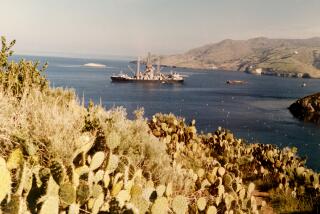Ghost of Russia’s K-19 Haunts Us
- Share via
The blockbuster starring Harrison Ford and Liam Neeson that is opening today, “K-19: the Widowmaker,” chronicles the terrifying early history of the Soviet Union’s first nuclear submarine, the K-19.
In July 1961, deep under the ice of the North Atlantic, the submarine’s coolant system failed, dangerously overheating its nuclear reactor. Several sailors entered the reactor compartment to improvise a cooling system. They died soon afterward from radiation poisoning. Twenty-one men eventually perished.
Amazingly, the K-19 is still with us, one of 190 decommissioned Soviet nuclear-powered submarines rusting at their piers. As many as 100 of them still have nuclear fuel on board, risking a reactor incident or diversion of material for a terrorist radiation weapon or “dirty bomb.”
The United States, through the U.S. Cooperative Threat Reduction program, has already spent more than $300 million dismantling ballistic-missile submarines and is planning to scrap 41 of these by 2007.
However, threat reduction legislation forbids funding work on nonstrategic nuclear-powered submarines. Russia does not have the money to scrap these 149 vessels, which pose proliferation as well as environmental risks.
Although not ballistic-missile platforms, attack submarines are nuclear-capable. They can launch land-attack cruise missiles with a range of almost 2,000 miles and carrying nuclear warheads 13 times more destructive than the bomb dropped on Hiroshima.
Since 1991, Russia has not armed its general-purpose submarines with nuclear weapons and has promised not to do so. However, the capability remains and should be eliminated while we have the opportunity.
Newer decommissioned boats could be recommissioned and even sold abroad. The Krasnoyarsk, an Oscar II submarine like the ill-fated Kursk, was launched in 1986 and has been laid up since 1995. Its crew is begging for funds to refurbish the boat.
As many as a dozen submarines could be recommissioned if the Russian economy continues to turn around. If money becomes scarce, that is all the more incentive for Russia to sell or lease boats to foreign countries.
Already, Russia is in talks with India over the leasing of two attack submarines.
Russia’s nuclear submarines also provide a tempting terrorist target. In 1998, a disgruntled sailor overpowered a guard and barricaded himself in the torpedo compartment of a Northern Fleet Akula-class submarine. He died attempting to set a fire.
A fire beneath the torpedoes would have led to the explosion of all of the submarine’s ammunition, which would have destroyed the submarine, neighboring nuclear submarines and the port town of Gadzhiyevo, not to mention the greater consequences of destroying the nuclear reactors.
Terrorists too have toyed with the idea of taking over a Russian submarine: In February, the Russian military discovered plans to hijack a Russian nuclear submarine. The plan, prepared by Islam Khasukhanov, chief of staff of the Chechen armed forces and a former deputy commander of a Soviet nuclear submarine, called for seven people of Slavic origin to board a submarine and place explosives in the torpedo, battery and reactor compartments as well as near the warhead of one of the missiles.
Decommissioned submarines also make tempting targets, and access is relatively easy. Guards have often been caught supplementing their meager incomes of about $35 a month by stealing and selling metal from the submarines they are supposed to guard, or taking bribes to look the other way as others steal from the vessels.
What can we do? It costs about $7 million to defuel and dismantle an attack submarine, no small sum. But the financial and human cost of cleaning up after a radiation incident would be immeasurable.
European nations and Japan have suggested that they are willing to help foot this bill but are waiting for the U.S. to lead the way. While we have done a lot already, we should direct a new effort to eliminate these boats while we have the chance.
The story of the K-19 is one of heroes willing to subject themselves to radiation to prevent its spread to the rest of us. Let’s prevent another tragedy so more men will not have to follow in their footsteps.
More to Read
Sign up for Essential California
The most important California stories and recommendations in your inbox every morning.
You may occasionally receive promotional content from the Los Angeles Times.













